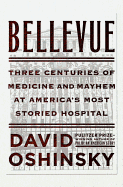
Bellevue in New York City is one of the oldest and most famous names in United States hospitals, known for housing violent criminals and mental health patients, the homeless and sufferers of rare and exotic diseases. The incredible, multi-layered history told by David Oshinsky in Bellevue: Three Centuries of Medicine and Mayhem at America's Most Storied Hospital covers medical and general history both national and global. This thorough narrative is wide-ranging and endlessly gripping.
The institution began in 1736 as an almshouse, where the indigent were housed and given rudimentary medical care. From these earliest days, "Bel-Vue" had a reputation for dealing with society's unwanted. Before modern considerations of medical ethics, this often meant experimenting on Bellevue's impoverished patients and their diverse range of ailments. Nevertheless, the hospital became central over the years in battling the yellow fever epidemic of the 1790s, the "Great Influenza" of the 1910s, the AIDS crisis of the 1980s, the September 11 attacks and Superstorm Sandy.
Bellevue's beauty and staggering scope lies in these historic, social and interdisciplinary connections. Bellevue's physicians have traveled the world and played roles in the scientific advances that have shaped modern medicine. Oshinsky (Pulitzer Prize-winner for Polio: An American Story) generally adheres to an impersonal, journalistic style, but his moving portrayal can't hide his admiration for this longstanding institution. Bellevue is that rare, page-turning history: engaging, smart, clearly written and of broad general interest. --Julia Jenkins, librarian and blogger at pagesofjulia

